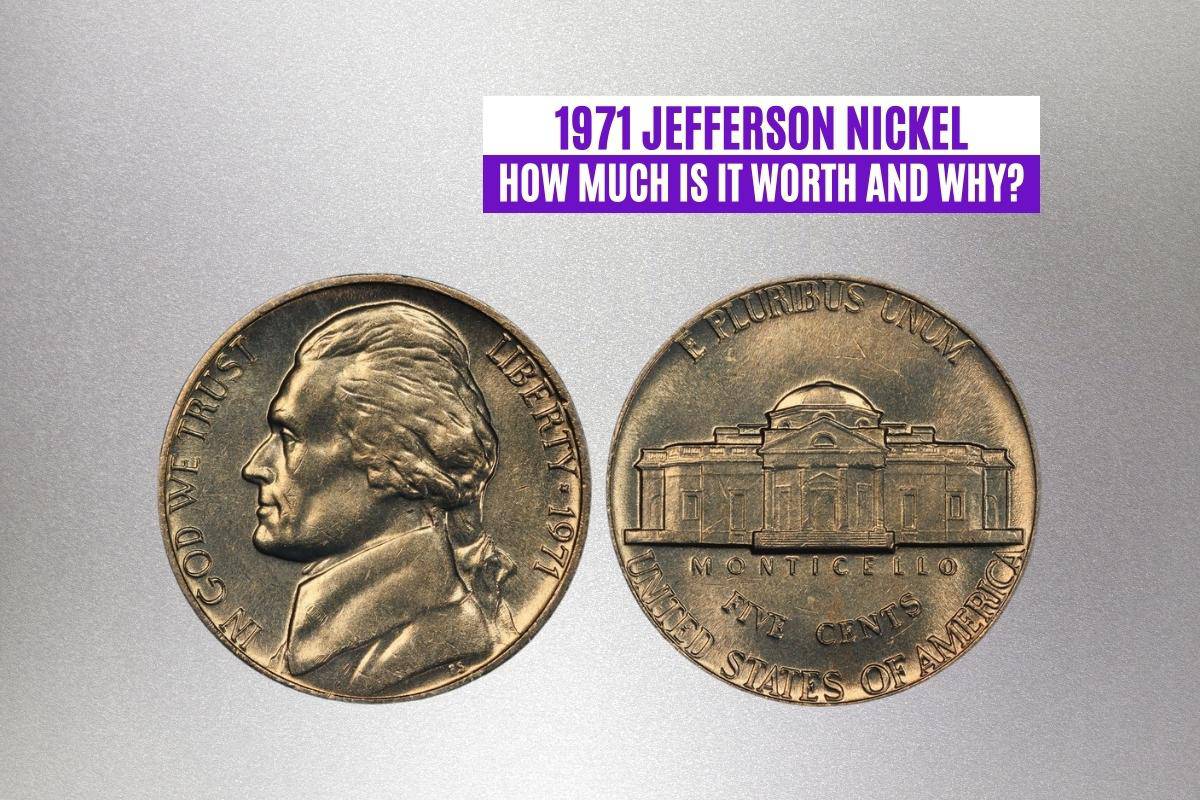The nickel is one of the lowest-value coins struck by the U.S. Mint, but this unassuming five-cent piece can be worth a small fortune under the right conditions! Take the 1971 Jefferson nickel, for example.
Although the 1971 nickel value starts at about $0.20, it can jump to thousands of dollars if you have one of the notorious “No S” proof-strike nickels from 1971. But this error coin isn’t the only valuable 1971 Jefferson nickel.
This guide will offer everything you need to know about this coin and its values, ensuring you understand how much your 1971 nickels are worth.
1971 Jefferson Nickel Value Chart
| Regular Strike | MS-65 | MS-66 | MS-67 |
| 1971-P Nickel | $20 | $36 | / |
| 1971-P Nickel FS | $22 | $55 | $2,050 |
| 1971-D Nickel | $12 | $20 | $75 |
| 1971-D Nickel FS | $16 | $40 | $525 |
| Proof Strike | PR-67 | PR-68 | PR-69 |
| 1971-S Proof Nickel | $3 | $5 | $10 |
| 1971-S Proof Nickel CAM | $8 | $10 | $14 |
| 1971-S Proof Nickel DCAM | $12 | $18 | $200 |
| 1971 No-S Proof Nickel | $950 | $1,150 | $1,850 |
| 1971 No-S Proof Nickel CAM | $1,025 | $1,200 | $2,150 |
| 1971 No-S Proof Nickel DCAM | $1,550 | $3,000 | $4,000 |
1971 Jefferson Nickel: History
The U.S. Mint produced fewer nickels in 1971 than the previous year, but the 1971 nickel shares a ton in common with all Jefferson nickels that came before it.
The Jefferson nickel design was introduced in 1938, and the coin saw few changes between then and 1971. One of the most significant changes is the change in mint mark location (which changed from the reverse to the obverse face) and the addition of the designer’s initials “FS” on the coin’s obverse (front) side.
It’s also important to note that this year heralded a rare mintage error. Just over 1,600 proof-strike nickels released in 1971 featured a mint mark mistake. These coins lacked the “S” that marked them as proof-strike coins produced at the San Francisco Mint.
1971 Jefferson Nickel: Design
The nickel hasn’t always featured the image of Thomas Jefferson on its obverse side. In fact, before 1938, the nickel featured the image of an indigenous American on its front face, with a buffalo on its reverse side.
This nickel (called the Buffalo nickel) wasn’t much beloved by U.S. Mint workers. After all, the intricate details of this design made it challenging to produce en masse, with coin die breaks causing consistent production problems.
So, in the late 1930s, the U.S. Mint released a nationwide competition for the new Jefferson coin design. To their pleasant surprise, they received several worthwhile entries.
But the design that caught their fancy was the one created by German-American sculptor Felix Schlag. This design (with a few small changes) became the Jefferson nickel design seen from 1938 to 2004. In 1966, Schlag’s initials were added to the design’s obverse to honor his contribution to U.S. coinage.
1971 Jefferson Nickel Obverse
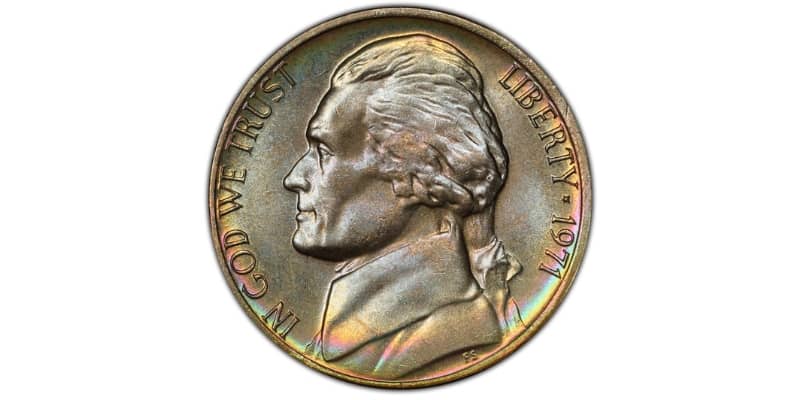
The 1971 Jefferson nickel has several design elements on its obverse (front) side, including:
- The device (raised image) of President Thomas Jefferson (facing left, face in profile)
- The motto “IN GOD WE TRUST” displayed vertically on the left side of the coin
- The legend “LIBERTY” displayed vertically on the right side of the coin
- The year date (1971) displayed vertically on the right side of the coin (beside the legend, separated by a small star)
- The initial “FS” beneath Jefferson (stands for Felix Schlag)
- The coin denomination (D or S) beneath the year date (behind Jefferson’s hair tie)
1971 Jefferson Nickel Reverse
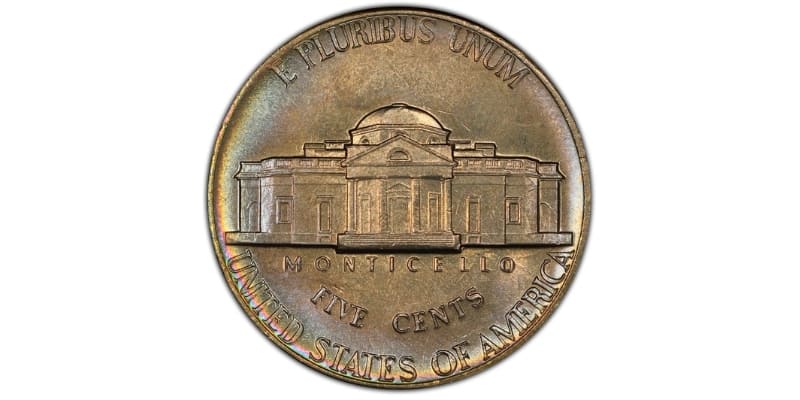
The 1971 Jefferson nickel has several design elements on its reverse (back) side, including:
- “E PLURIBUS UNUM” (motto) at the top of the coin
- The device (raised image) of Thomas Jefferson’s plantation, Monticello, in the center of the coin
- The text “MONTICELLO” beneath the device
- “FIVE CENTS” (coin denomination) beneath the text “MONTICELLO”, curving upward
- The issuing nation “UNITED STATES OF AMERICA” at the bottom of the coin
1971 Jefferson Nickel: Features and Specifications
When examining 1971 Jefferson nickels, there’s far more to look for than just design. These five-cent coins have several other attributes in common, including size, edge type, and metal composition.
So, when identifying a Jefferson nickel from 1971, you might also want to check that your coin exhibits the following features:
- A diameter of 0.83 inches (21.2 millimeters)
- A weight of 0.18 ounces (5 grams)
- A metal composition of 25% nickel and 75% copper
- Smooth (plain) edges
How Much Is a 1971 Jefferson Nickel Worth?
According to PCGS, a 1971 No Mint Mark Jefferson nickel is worth between $0.20 and $0.30 when found in circulated condition. It can be worth $2 to $36 (or more) in uncirculated condition.
1971 Jefferson Nickel: Value Comparison
Although the average No Mint Mark 1971 Jefferson nickel isn’t worth much more than its listed denomination of $0.05, some nickels from this year can be worth thousands. The determining factors impacting the value of this nickel are:
- Coin grade (PCGS or NGC)
- Coin strike type (regular or proof)
- Coin rarity (determined by where it was minted)
- The presence of errors (most notably the “No S” error)
Generally, the least valuable 1971 Jefferson nickels are heavily circulated ones with the “D” mint mark (struck at the Denver Mint). These are the most common types of Jefferson nickels, and they’re rarely found in uncirculated condition (MS-60 grade or higher).
However, if you have a 1971-S “No S” proof-strike Jefferson nickel, particularly one with a deep cameo effect, you’re looking at a coin worth big bucks!
Unsure how much your 1971 Jefferson nickels are worth? Check out the in-depth value comparison below for more information.
1971 No Mint Mark Jefferson Nickel Value
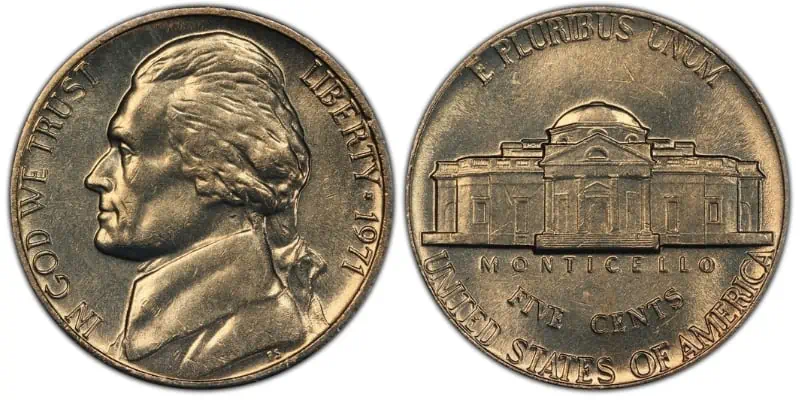
Regular-strike (for-circulation) 1971 Jefferson nickels that don’t have a mint mark on their obverse (front) faces are called 1971 No Mint Mark (or 1971-P) nickels. These nickels were struck at the Philadelphia Mint, which produced the lowest volume of regular-strike nickels in 1971.
The Philadelphia Mint struck just shy of 107 million nickels in 1971, about 209 million fewer than the Denver Mint. As a result, 1971 No Mint Mark nickels are slightly rarer than 1971-D Jefferson nickels.
However, most are fairly worn because these coins were made for circulation. Consequently, most of these coins are in somewhat lackluster condition, with most earning a grade of G-4 (good condition) or less.
The most valuable of these nickels are those in uncirculated condition (grade MS-60 or higher). In good condition (G-4), a 1971 No Mint Mark nickel is worth about $0.20. In about uncirculated condition (AU-50), this five-cent coin is worth about $0.30.
But an MS-60 1971 No Mint Mark nickel is worth $2, while an MS-66 piece is worth about $36.
Still, the 1971 No Mint Mark Jefferson nickel is available in two varieties:
- Full Step (FS), and
- Non-FS (Not Full Step)
The more valuable of these two types is the Full Step nickel.
Full Step
The Full Step nickel has a full set of steps (five to six) leading up to Monticello. This tiny design detail wears away quickly when nickels enter circulation, so it’s rarely seen in regular strike Jefferson nickels.
The steps of Monticello on a Jefferson Nickel are often weakly struck on circulation issues. Nickels that have more sharply struck steps (called “full steps”) are more desired by collectors.
1971 Jefferson nickels (regular strike) removed from circulation early on are often the only pieces retaining the Full Step design detail. For this reason, you’ll generally only find Full Step 1971 Jefferson nickels in uncirculated condition.
An MS-60 FS 1971 No Mint Mark nickel is worth about $3. An MS-66 version is worth about $55, almost $20 more than a non-FS 1971 No Mint Mark nickel with an equivalent grade.
Still, the most valuable FS 1971-P Jefferson nickel is one with a grade of MS-67+. One of these nickels can sell for $5,500 or more!
1971-D Jefferson Nickel Value
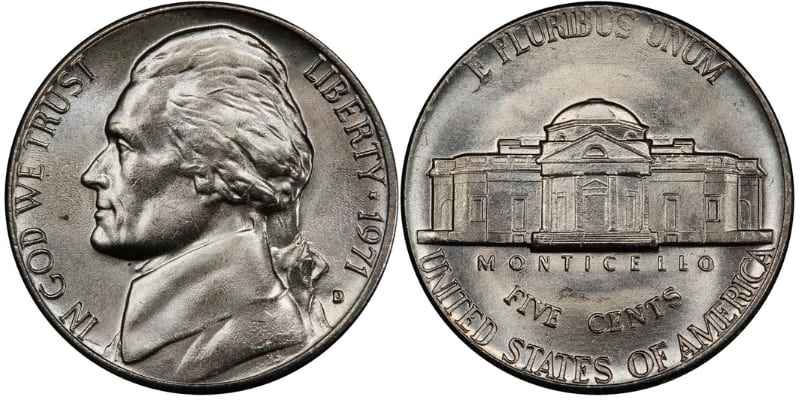
The 1971-D Jefferson nickel is far more common than the No Mint Mark 1971 nickel. Consequently, it tends to be slightly less valuable, even when in uncirculated condition.
In good (G-4) or about uncirculated (AU-50) condition, a 1971-D Jefferson nickel is worth about $0.20.
In uncirculated condition (MS-60 or higher), this coin has an estimated value of $1 (MS-60) to $75 (MS-67). An MS-66 1971-D nickel is worth about $20, making it less valuable than the harder-to-find 1971 No Mint Mark nickel (of the same grade).
But just like the 1971 No Mint Mark nickel, the Full Step variety is more valuable. Still, the value of the FS 1971-D nickel isn’t much higher than those of the non-FS variety.
Full Step
A Full Step (FS) 1971-D Jefferson nickel is worth between $2 (MS-60) and $525 (MS-67). All told, this type of Jefferson nickel is far less valuable than the FS 1971 No Mint Mark nickel, likely because it’s more common, even in higher grades.
1971-S Proof Jefferson Nickel Value
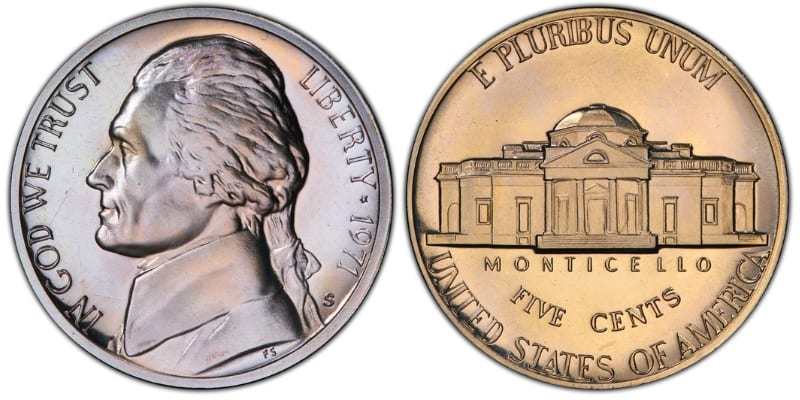
The San Francisco Mint was responsible for producing proof-strike nickels in 1971.
This U.S. Mint facility struck just over 3 million proof-strike Jefferson nickels that year, none of which entered circulation. You can identify this coin by the small “S” on its obverse face (unless it’s a “No S” error coin).
As such, all 1971-S proof-strike nickels are in excellent condition. You likely won’t find one of these coins with a grade less than PR-60!
The 1971-S proof-strike Jefferson nickel is available in three varieties:
- Proof
- Proof Cameo
- Proof Deep Cameo
The standard proof-strike (non-cameo) is the least valuable, while the most valuable tends to be the deep cameo version. That’s because the cameo and deep cameo effect are harder to come by, making such proof-strike coins comparatively rare.
A 1971-S proof-strike (non-cameo) nickel is worth about $1 when in PR-60 condition. In PR-69 condition, one of these proof-strike pieces is worth about $10.
Cameo
Cameo coins have a tonal difference, giving them a brighter foreground (raised portions) and a darker background (field).
A cameo 1971-S proof-strike Jefferson nickel in PR-60 condition is worth about three times as much as a non-cameo one, with an estimated worth of about $3. a 1971-S CAM nickel in PR-69 condition is slightly more valuable, with an approximate value of $14.
If you’re looking for the most valuable non-error proof-strike nickels from 1971, you’ll want to keep an eye out for deep cameo nickels.
Deep Cameo
Deep cameo coins take the cameo effect to the next level, with an almost black field (background) and white raised portions. A 1971-S DCAM nickel is worth significantly more than a standard non-cameo 1971-S proof-strike coin.
A PR-60 DCAM 1971-S nickel is worth about $3 (the same as a 1971-S CAM nickel). But a PR-69 DCAM 1971-S nickel is worth a jaw-dropping $200! That’s a significant improvement over the $14 worth of a 1971-S CAM nickel.
1971 No-S Proof Jefferson Nickel Value
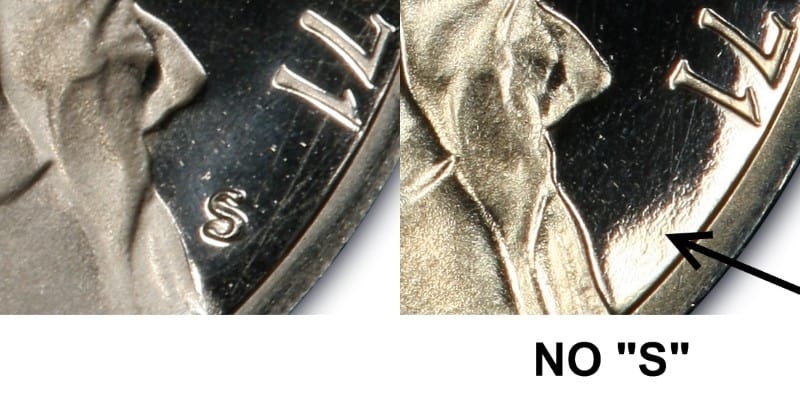
Due to a mint engraving error, about 1,600 proof-strike 1971 nickels were produced without the “S” mint mark. These coins are called the “No S” 1971 Jefferson nickel and are the most valuable 1971 nickels available.
The 1971 “No S” Proof Jefferson Nickel is the only coin in the entire Jefferson Nickel series that has been struck without containing the intended mint mark. It was accidentally struck with a proof die that was missing the S mint mark.
Like the 1971-S Jefferson nickels, these coins are divided into three subtypes based on the presence and intensity of the cameo effect. As you might imagine, the least valuable of these error coins lack the cameo effect.
Still, these coins can fetch hundreds of dollars. For example, a 1971 “No S” proof-strike coin with a grade of PR-63 is worth about $810. One in PR-69 condition can sell for upwards of $1,850.
Cameo
Do you have a 1971 “No S” CAM nickel? If so, your coin collection might be far more valuable than you think!
A 1971 “No S” CAM Jefferson nickel has an estimated worth of $850 in PR-64 condition. In PR-69 condition, one of these coins can sell for $2,150 or more.
Notably, a 1971 “No S” CAM nickel isn’t worth as much as non-cameo versions in lower grades. That’s probably because 1971 “No S” CAM nickels in lower grades are more common than non-cameo nickels in similar (PR-65 or lower) grades.
Deep Cameo
The deep cameo (DCAM) 1971 “No S” proof-strike nickel is the most valuable of them all. One of these coins in PR-63 condition can sell for $950, while one in PR-69 condition can sell for $4,000 or more!
This above-average value stems from the coin’s rarity, as there are probably only a few dozen 1971 “No S” DCAM nickels.
1971 Jefferson Nickel: Rare Errors
The most prevalent 1971 Jefferson nickel error is the “No S” proof-strike coin. But did you know that there are other error nickels from 1971?
These error coins are far rarer than the “No S” coins and can also be worth big bucks. Two types of errors to look for in 1971 Jefferson nickels include:
- The wrong planchet error, and
- The multiple-strike error
Let’s explore these errors to discover how they occur and how they impact a 1971 nickel’s value.
1971 Jefferson Nickel Wrong Planchet Error
Every coin features a unique metallic makeup. For example, modern pennies are made of copper and zinc, while dimes are made of copper and nickel.
Before a coin is struck, machines punch out the blanks (also called planchets) from pre-prepared strips of metal for each coin type. These blanks then pass between coin dies, which are like large metal stamps. Coin dies give each coin its design!
However, sometimes coin planchets end up between the wrong dies. When this happens, you get a “wrong planchet” error coin. These coins can be quite valuable, with many selling for hundreds of dollars at auction.
One of the most valuable wrong-planchet error nickels from 1971 is a piece struck on a penny planchet. This coin sold for $2,640 in 2021.
But the penny planchet isn’t the only reason this coin sold for a premium price; it was also a double-struck coin. Coins that feature multiple strikes can often sell for high prices.
1971 Jefferson Nickel Multiple-Strike Error
Sometimes, a coin sticks to the coin dies. When this happens, a coin can end up being struck with the dies multiple times, often resulting in a significantly warped error coin.
It’s important to remember that coin dies squeeze a coin with significant pressure to impart designs, and when a coin is struck multiple times, the high pressure can “squeeze” the coin into an unusual shape.
Fortunately, this process makes multiple-strike error coins easily identifiable. You can see this for yourself in the triple-struck 1971-D Jefferson nickel that sold for $1,200 in 2022.
This coin isn’t perfectly round thanks to the multiple die strikes. It also features three Jefferson devices on its obverse face (or faces).
Frequently Asked Questions
Do you have additional questions about the 1971 Jefferson nickel? Don’t hesitate to check out the frequently asked questions below.
What’s the Auction Record for the 1971 Jefferson Nickel?
The auction record for the 1971 Jefferson nickel belongs to a PR-69 Deep Cameo “No S” proof-strike nickel that sold for $7,638 in 2016.
This record-setting price stems from the “No S” proof-strike 1971 nickel being rare, with fewer than 2,000 thought to exist. Most of these are in non-cameo condition, making the deep cameo version even scarcer (and more valuable).
How Many 1971 Jefferson Nickels Exist?
The U.S. Mint struck just over 423 million regular-strike Jefferson nickels in 1971. It’s unknown how many of these nickels exist today.
However, it’s likely that most are either still in circulation or part of private collections, making the 1971 Jefferson regular-strike nickel fairly common.
What’s the Rarest 1971 Jefferson Nickel?
The rarest 1971 Jefferson nickel is the “No S” proof-strike error nickel. In terms of non-error nickels, the rarest one from 1971 is the proof-strike (With S) coin, followed by the 1971 No Mint Mark nickel.
1971 Jefferson Nickel: Final Thoughts
The average 1971 nickel value $0.20, about four times the coin’s original value. But 1971 Jefferson nickels in uncirculated condition (those with a grade of MS-60 or higher) can be worth more.
The most valuable of all 1971 nickels are the “No S” proof-strike pieces. There are fewer than 2,000 of these coins, making them particularly valuable. Some even sell for thousands of dollars.
Are you a coin collector looking to improve your collection? Check out these related articles now!

